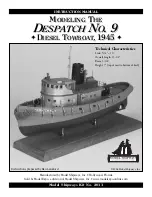
8
Shaping The Machine-carved Block
- The
block is fairly close to scale except the aft end
is about 1/8" too long. You should cut this
off so the length of the deckhouse block
matches the plan. However, if you don't, it
just means that the overhanging deck does
not hang over as much.
Test fit the upper deck laser-cut part to the
block. It may be necessary to carve out
around the pilot house and captain's cabin
for it to fit. Next, test fit the forward portion
of the visor around the front of the pilot
house. If it does not fit well, sand the front
curve of the pilot house until it does. You
could also alter the laser-cut part a bit.
Installing The Upper Deck And Pilot
House Top Laser-cut Parts (Figure B-6)
-
Before gluing the parts in place, cut the taper
for the visors on both the pilot house and
main cabin tops. You could wait until the
parts were glued in place but it may be easier
to do it beforehand. When you taper the
visor, don't get it so thin at the outer edge
that it could get damaged. Note that the
visor on the real boat is a plate with plate
brackets underneath. A detail of the real boat
visor is shown on the plans.
Shaping And Installing The Cabin Trunk.
Skylight, And Stack (Figure B-7)
- The
block for the cabin trunk must be shaped on
the bottom to fit the deck. First, use a sand-
ing block and sand the sheer of the deck,
You only need to take a little off the forward
end to make it fit. Then, sand in the deck
camber until the block fits flush.
The top of the cabin trunk has an overhang
about 3/32" on each side. Add a piece of
basswood on each side to form the overhang,
then glue the block in place.
For the skylight block there is not much to
do except check the length and width and
drill holes for the airports.
The top of the stack is a laser-cut piece.
There are also laser-cut rims for the two
exhaust holes in the top. Glue these rims over
the holes. The stack block must be shaped
into an oval and the shape is just slightly
smaller than the laser-cut top, so use the top
as a guide while carving the stack shape.
Installing The Bulwark And Fashion
Bracket Pieces (Figure B-8)
- Use 1/32"
thick, basswood and cut out the fashion piece
and bulwark at the pilot house. Install the
bulwark first and add a 1/32" thick x 3/32"
wide cap rail on top. When you get to the
pilot house, the outer edge of the rail goes all
around the front of the pilot house as a
moulding. Use 1/32" square strip for this.
Add the fashion brackets on each side of
the main cabin supporting the aft upper
deck overhang. Use 1/32" basswood for
this bracket.
Most of the remaining details on the deck-
house can be added before the deckhouse is
installed on the deck. These details are dis-
cussed in Stage D so look ahead.
Before proceeding with additional work it is
best to mount the hull. This step will help
prevent details from becoming damaged dur-
ing handling and will allow you to make any
alignments that require a true waterline. Prop-
er mounting of the hull is very important and
will allow the accurate building and aligning
of the remainder of the model. The kit does
not include any parts for mounting. However,
the following suggestions are provided.
Mounting Board With Two Pedestals
- A
common mounting for ship models is a
wooden baseboard with two wooden or brass
pedestals. For a homemade board, a nice
looking hardwood such as cherry, walnut, and
maple would be ideal. You can round the top
edges of the baseboard, or cut a simple cham-
fer. If you own a router, or can borrow one,
you will be able to cut a nice fancy edge on
the baseboard. Stain the base if necessary
and give it a few coats of varnish or finish
like Minwax.
The pedestals could be wood or brass. One
pedestal needs to be longer than the other
because you should have the model mounted
with the waterline parallel to the baseboard.
If you decide on this
type mounting you
should already have
drilled pilot holes for
the screws as noted
earlier. For
Despatch
No. 9, the pedestals
should be located
near station 4 and 7.
If something went
awry and the water-
line is not level, you
can add a brass shim
under one pedestal to
correct it.
Baseboards and
pedestals are available
from Model Expo
(www.modelexpo-
online.com).
Launching Ways
- A second type of mount-
ing that can be employed is the launching
ways, which are most suitable for models
without sails. Drilling of the keel is still
required to insert rods that anchor the model
to the ways. The launching ways should be
mounted on a baseboard or could be placed
in a diorama comprised of boatyard ground
activity.
Launching way designs can be found from
photographs of ships and boats in shipyards.
A design for a simple launchway is shown in
Fig. C-1. You'll adjust the size needed for
Despatch No. 9.
STAGE C:
MOUNTING THE HULL
FIG. B-8 UPPER DECK BULWARK
1/32" x 1/32"
HALF-ROUND
MOULDING
1/32"
FASHION
BRACKET
1/32"
BULWARK
1/32" x 3/32"
RAIL
FIG. C-1 LAUNCHING WAY MOUNTING
WATERLINE
PARALLEL TO BASE
METAL ROD
OR WOOD
DOWEL
IN KEEL
BASE
KEEL BLOCKS
CROSS TIMBERS
SUPPORT
RAIL
SIDE SUPPORT
STRUTS
1/4" SQUARE
WOOD FOR
1/8" - 1/4" SCALE
MODELS
SUPPORT BLOCKS
HEIGHT SET SO MODEL WATERLINE
WILL BE PARALLEL TO BASE
SIDE SUPPORT
STRUTS P/S
ABOUT
1.5 X BEAM
OF HULL






























